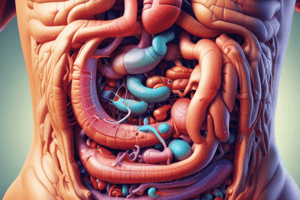Podcast
Questions and Answers
What type of transport primarily facilitates water absorption in the small intestine?
What type of transport primarily facilitates water absorption in the small intestine?
- Secondary passive diffusion
- Secondary active transport (correct)
- Osmosis only
- Simple osmosis with no energy requirement
During mal digestion, which phase of digestion is most likely to be affected?
During mal digestion, which phase of digestion is most likely to be affected?
- Absorption phase in the large intestine
- Transport phase in the bloodstream
- Membrane digestion phase (correct)
- Glycocalyx enzyme secretion phase
Which electrolyte is notably involved in the transport mechanisms within both small and large intestines?
Which electrolyte is notably involved in the transport mechanisms within both small and large intestines?
- Magnesium
- Iron
- Calcium
- Potassium (correct)
Which of the following statements regarding absorption in the intestines is correct?
Which of the following statements regarding absorption in the intestines is correct?
What role does the sodium gradient created by Na+/K+ ATPase play in intestinal function?
What role does the sodium gradient created by Na+/K+ ATPase play in intestinal function?
Flashcards
Water absorption in small intestine
Water absorption in small intestine
Primarily occurs via secondary active transport, using a sodium gradient created by the Na+/K+ ATPase.
Maldigestion
Maldigestion
Difficulty in breaking down food during digestion.
Membrane digestion
Membrane digestion
Digestion occurring at the level of the cell membrane.
Glycocalyx role in digestion
Glycocalyx role in digestion
Signup and view all the flashcards
Absorption in Intestines
Absorption in Intestines
Signup and view all the flashcards
Study Notes
Absorption in Small and Large Intestine
- The small intestine has villi and microvilli, increasing the surface area for absorption.
- Goblet cells secrete mucus.
- Capillary networks absorb nutrients.
- Crypt cells are proliferative and secrete water and electrolytes.
- The small intestine epithelium is replaced every 3-6 days.
What will we talk about?
- Digestion, absorption and transport
- Water and electrolyte absorption
- Water absorption
- Sodium absorption
- Secretion of water and electrolytes
- Potassium
- Calcium
- Iron
A- The Surface
- The intestinal mucosa has finger-like projections called villi.
- The intestinal epithelial cells are on the surface of villi, and the glands are at the base.
- Microvilli increase the absorptive surface area of the small intestine significantly.
Crypt Cells
- Crypt cells secrete water and electrolytes.
Absorption Overview
- There are eight layers in the absorptive pathway.
- The glycocalyx contains digestive enzymes.
- The apical membrane and basolateral membrane absorb nutrients.
- Intercellular spaces, basement membranes, and capillary/lymph vessel walls are also part of the system.
- Tight junctions preserve the integrity of cells.
Transport Processes
- Simple diffusion involves high concentration to low concentration.
- Active transport requires energy and accumulates substances against their concentration gradient.
- Secondary active transport is through specific protein carriers, using the Na⁺ gradient from ATPase activity.
- Facilitated diffusion uses carriers, but does not accumulate against the concentration gradient.
Water and Electrolyte Absorption
- Total fluid intake is about 2 liters, plus secretions (1500mL saliva, 2000mL in gastric secretions, 500mL pancreatic juices, 1500mL intestinal secretions 100mL excreted) making a total of ~9 liters to be absorbed.
- Water absorption happens mainly in the small intestine; the small intestine absorbs 85% of body water. The remaining 15% is absorbed in the colon.
- Water absorption rate depends on the location, active solute transport, and luminal osmolality.
- Duodenum and jejunum have larger pores, allowing easier absorption than the ileum.
- Water moves from high osmolality to low osmolality in the intestines.
- Water absorption can be impacted by ingested meal type (hypotonic or hypertonic).
Sodium Absorption
- The small intestine is efficient at conserving sodium, absorbing over 95% of the sodium load.
- Absorption mostly occurs in the jejunum (over half), with some in the ileum and colon.
- Several mechanisms are involved, including electrogenic, non-electrolyte-stimulated, neutral chloride absorption, and passive sodium absorption.
- Glucose absorption can be linked to sodium absorption.
Potassium Absorption
- Potassium absorption happens mostly passively in the jejunum, down its concentration gradient.
- The concentration gradient for potassium is relatively high in the lumen (14mEq/L) compared to the plasma (4mEq/L).
Calcium Absorption
- Adults ingest about 1g of calcium daily; half comes from milk and milk products.
- 200-300 mg more calcium is secreted into the intestines through digestive juices.
- Calcium is absorbed actively when luminal concentration is lower than plasma (5mEq/L).
- Higher luminal concentrations can be absorbed via simple diffusion .
Iron Absorption
- Average daily intake of iron is 10-20mg.
- Iron is found in food as myoglobin or hemoglobin.
- Hydrochloric acid and proteolytic enzymes release it from food in the stomach.
- Ascorbic acid reduces ferric to ferrous form.
- In the small bowel, iron binds to molecules like ascorbic acid, increasing its solubility and absorption.
Studying That Suits You
Use AI to generate personalized quizzes and flashcards to suit your learning preferences.




